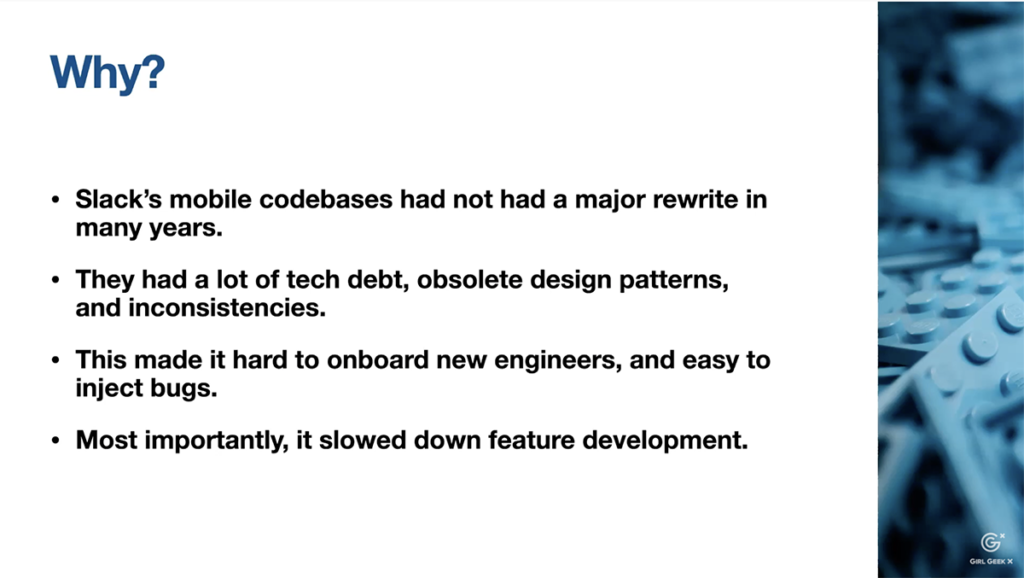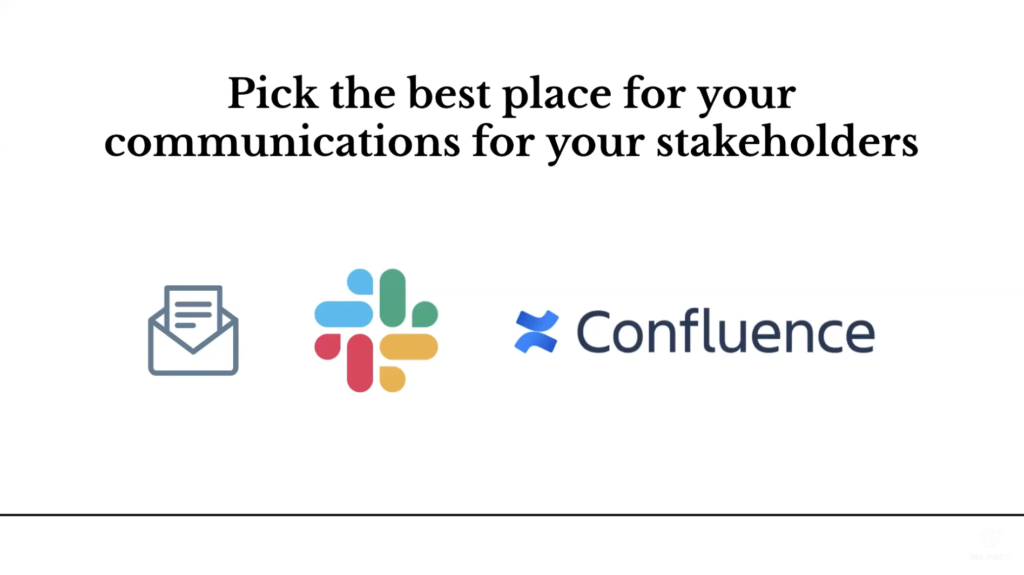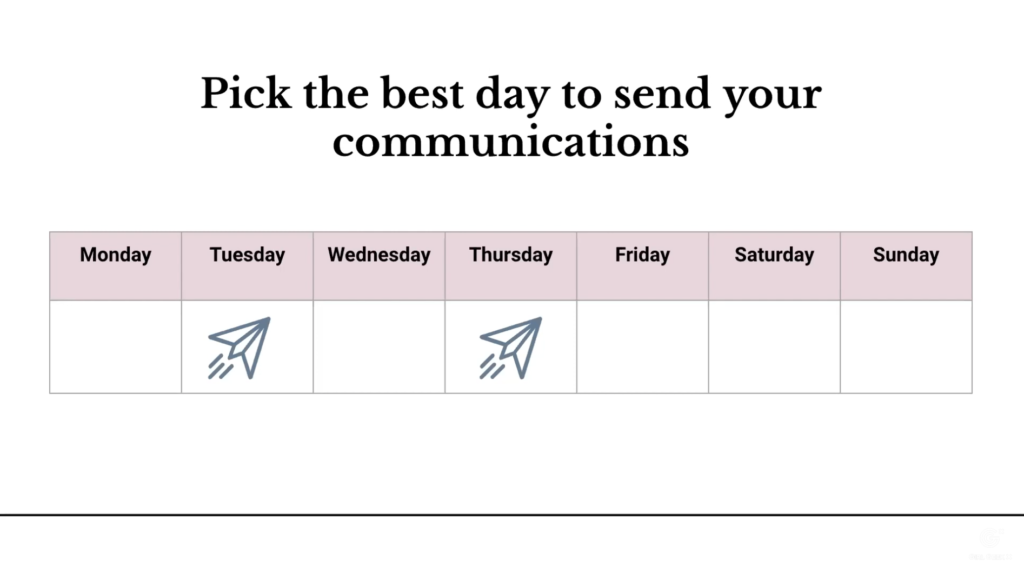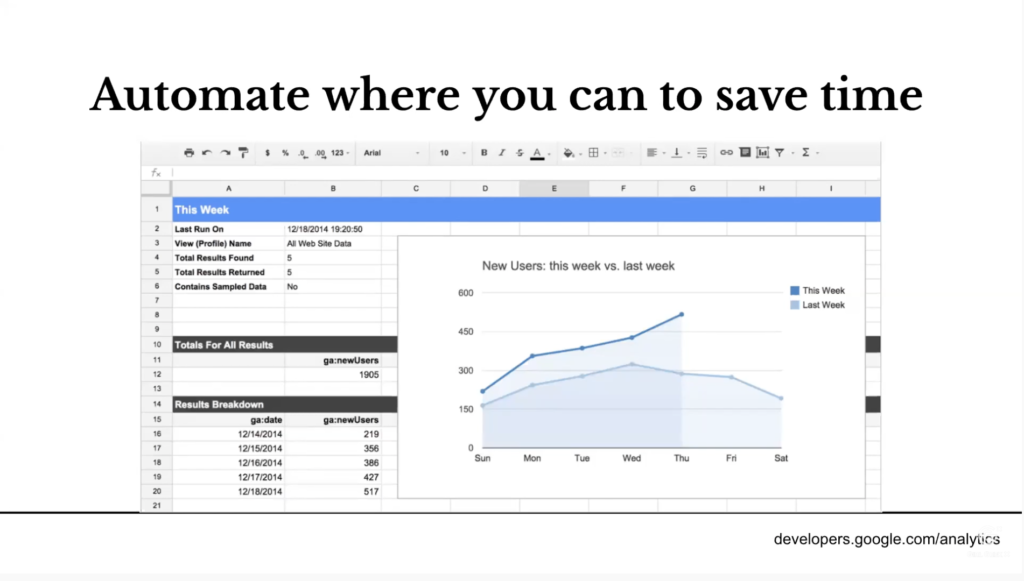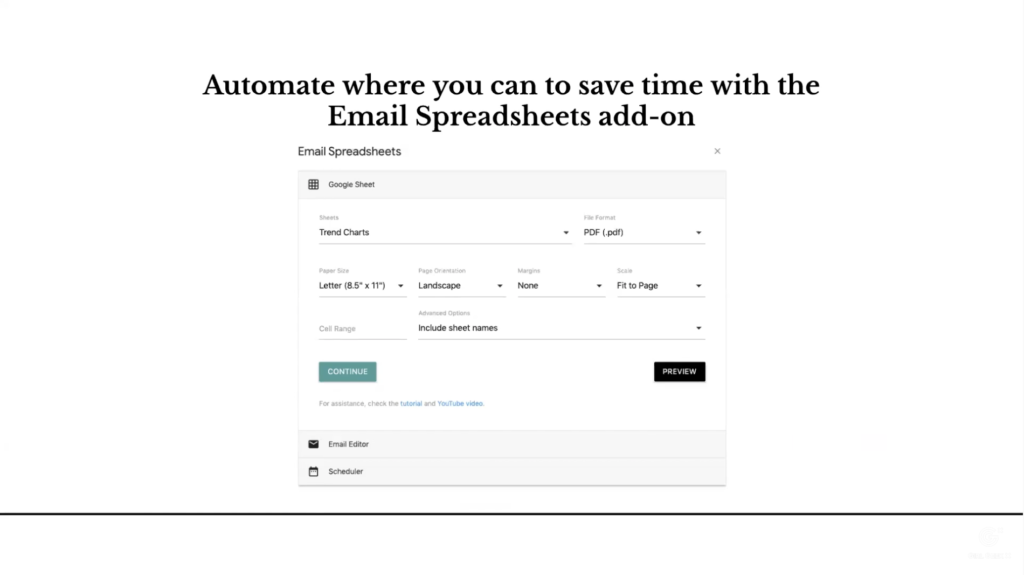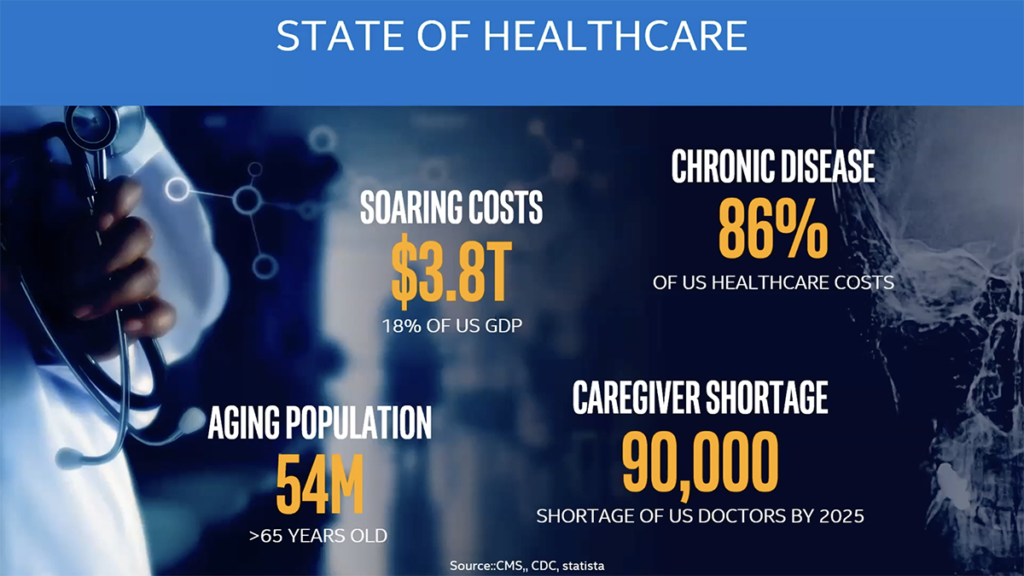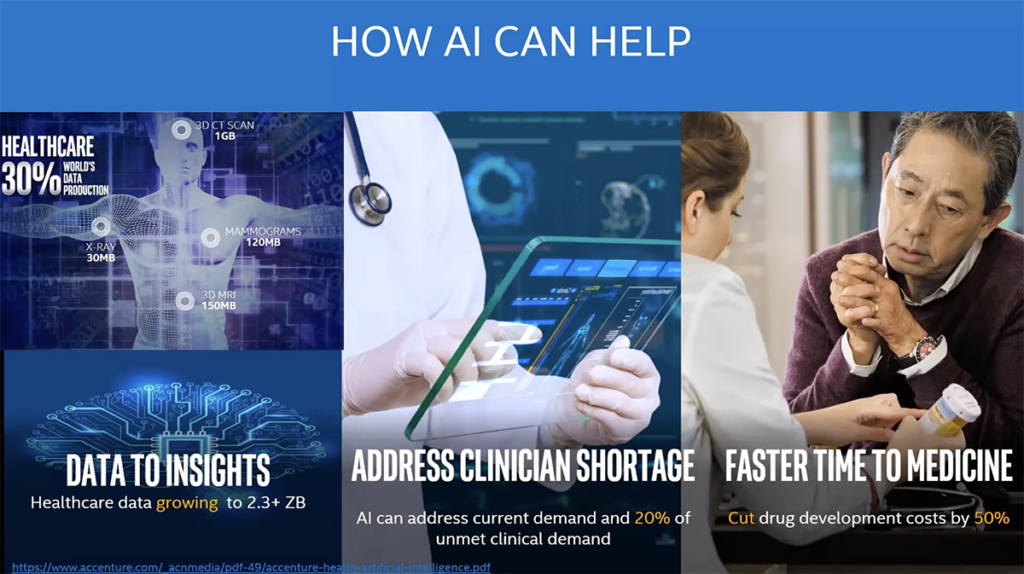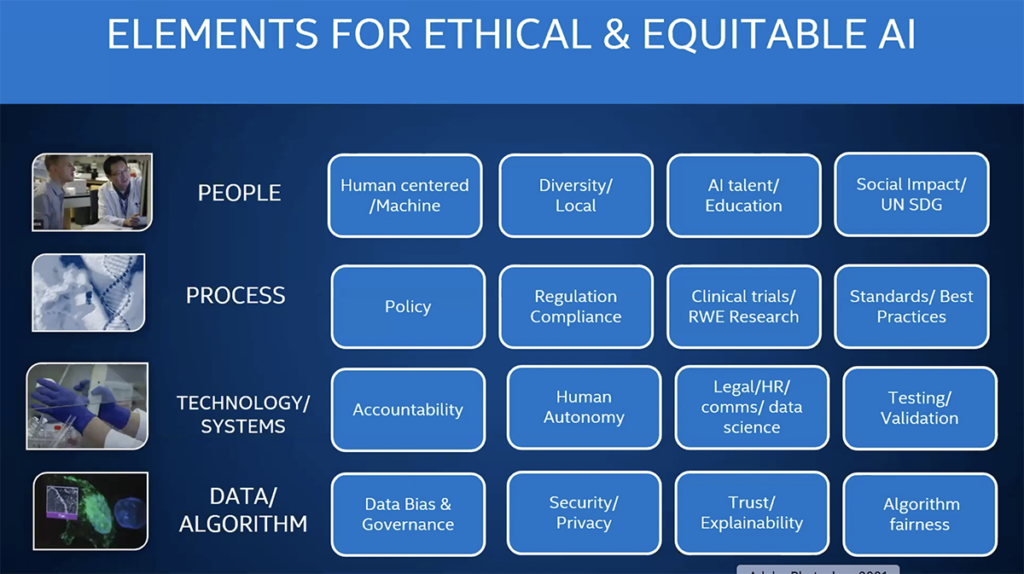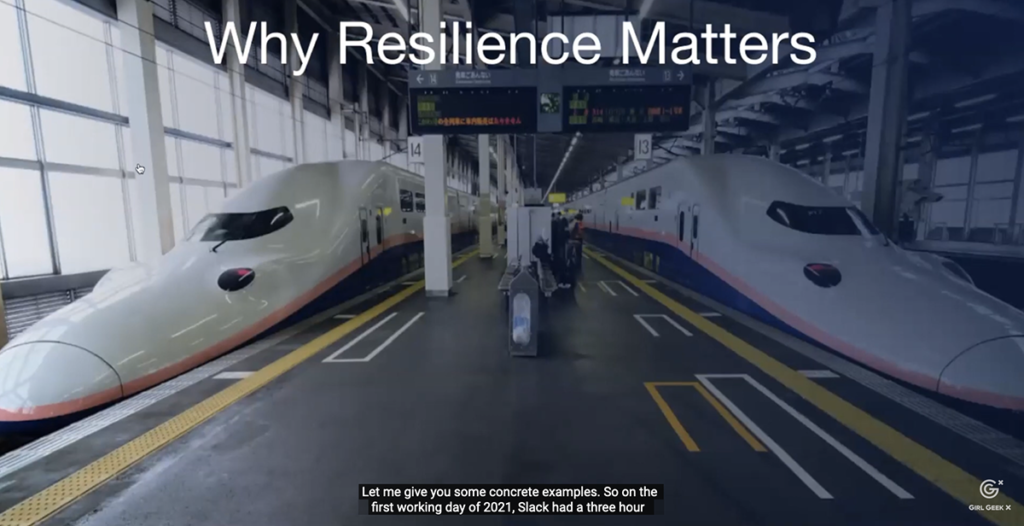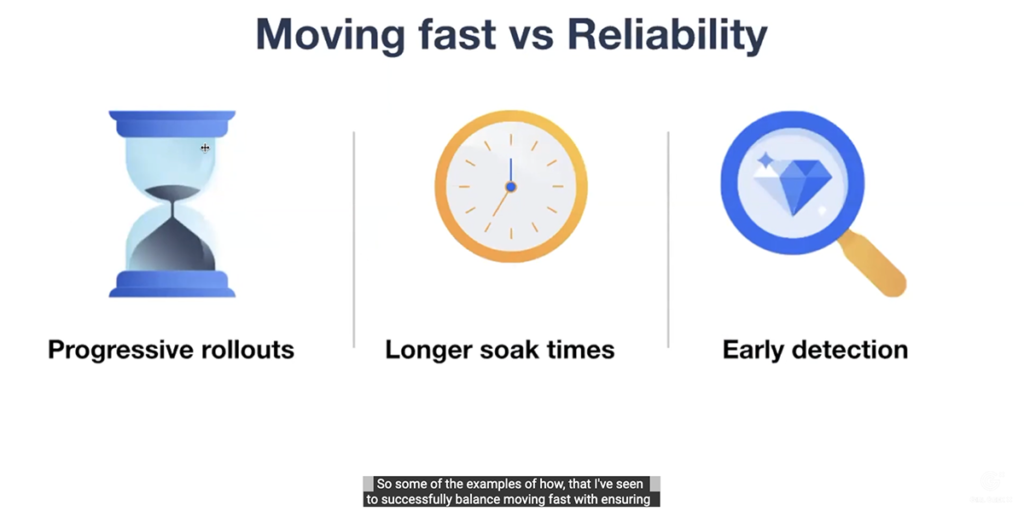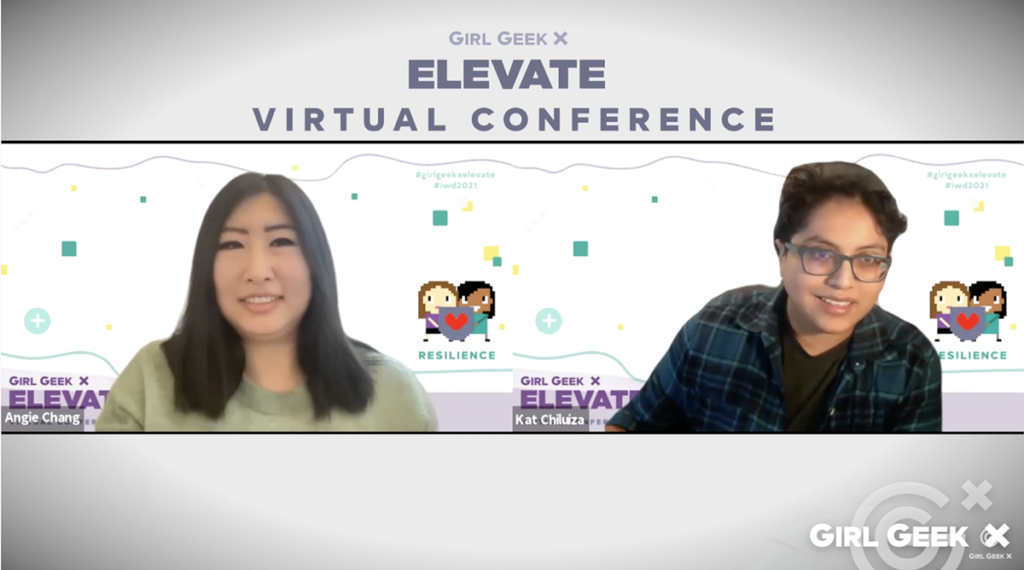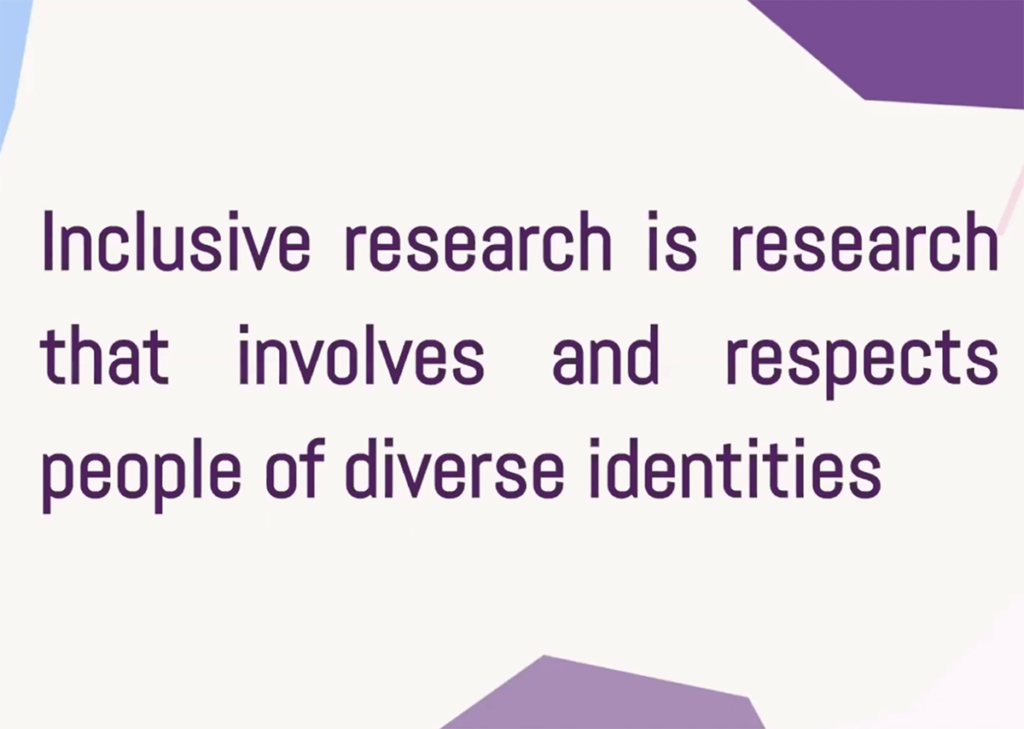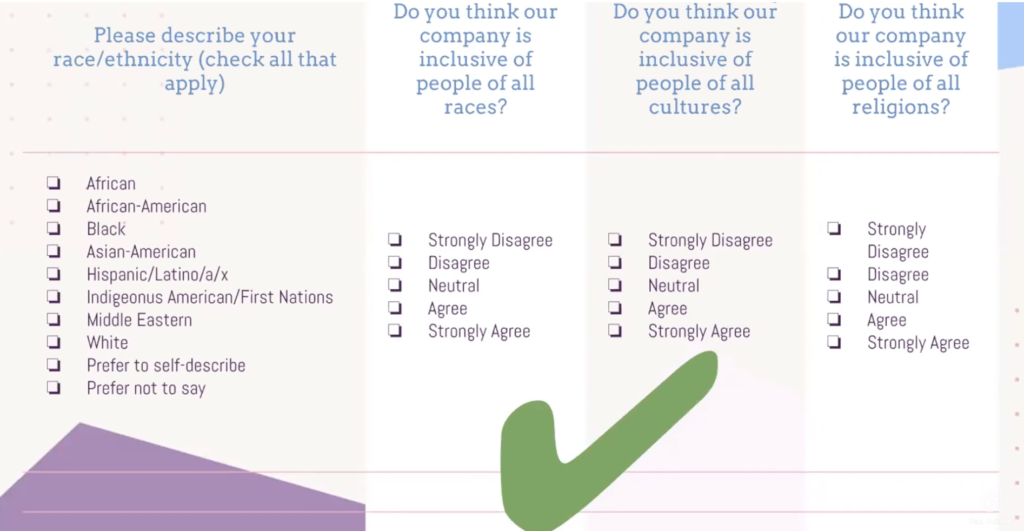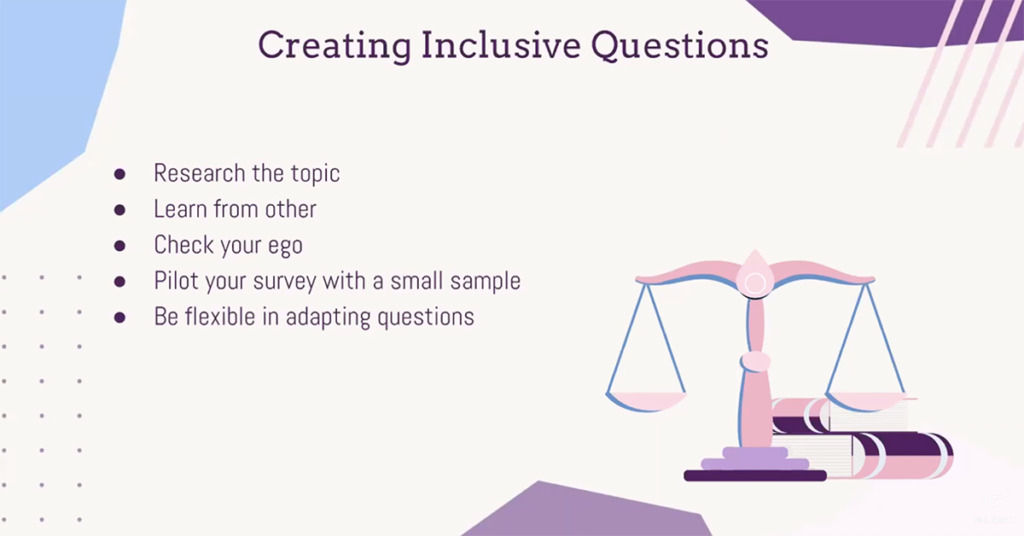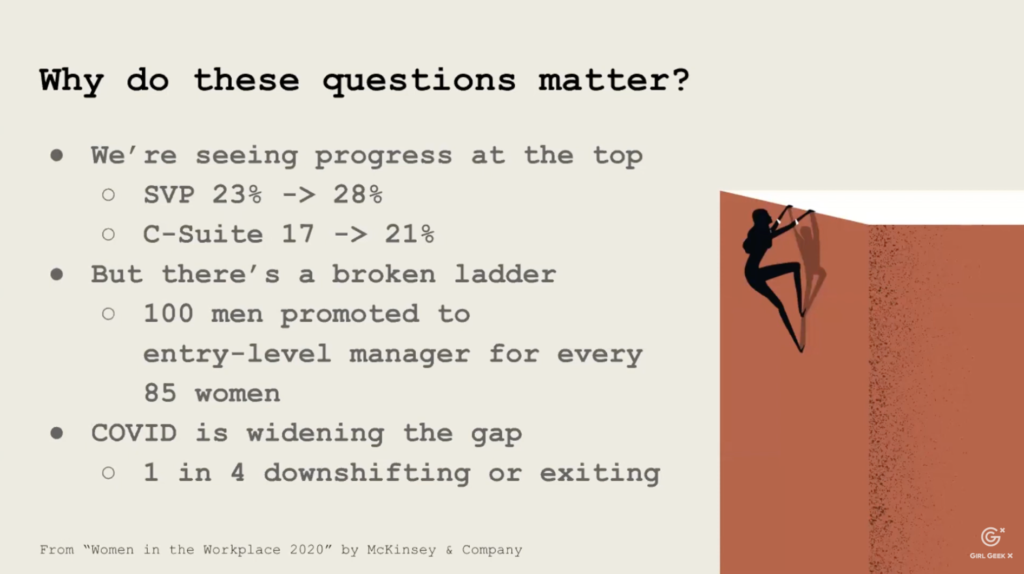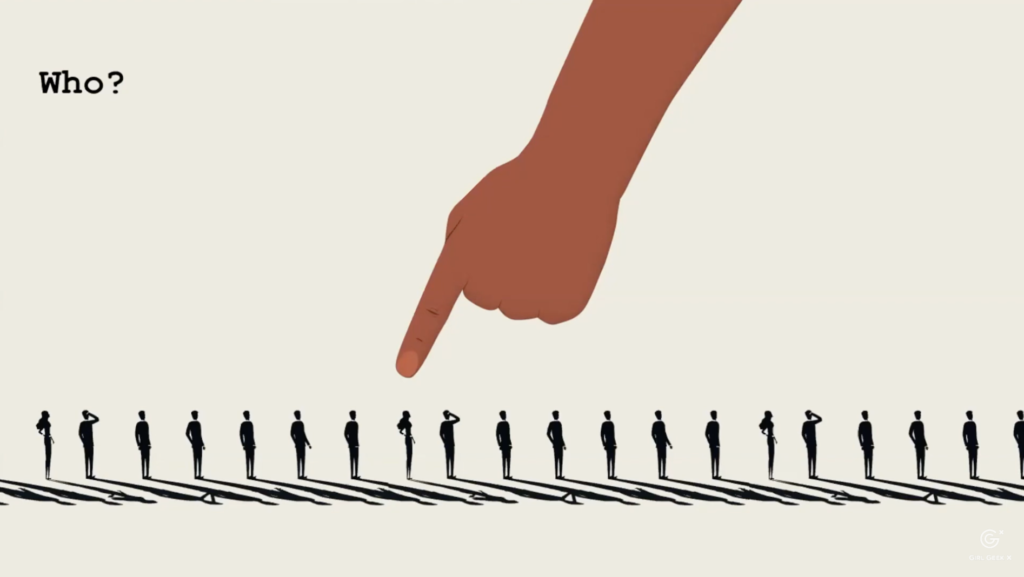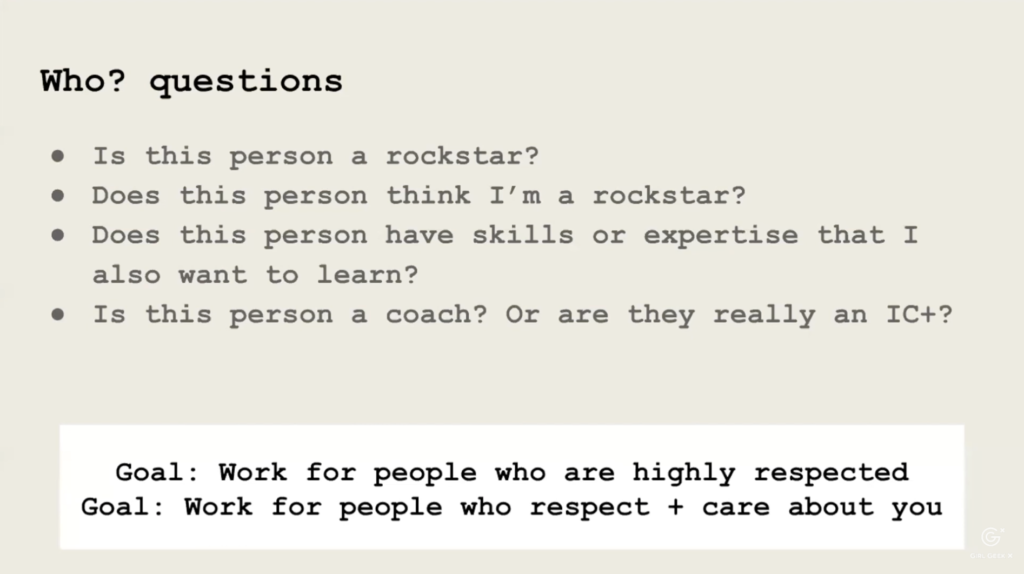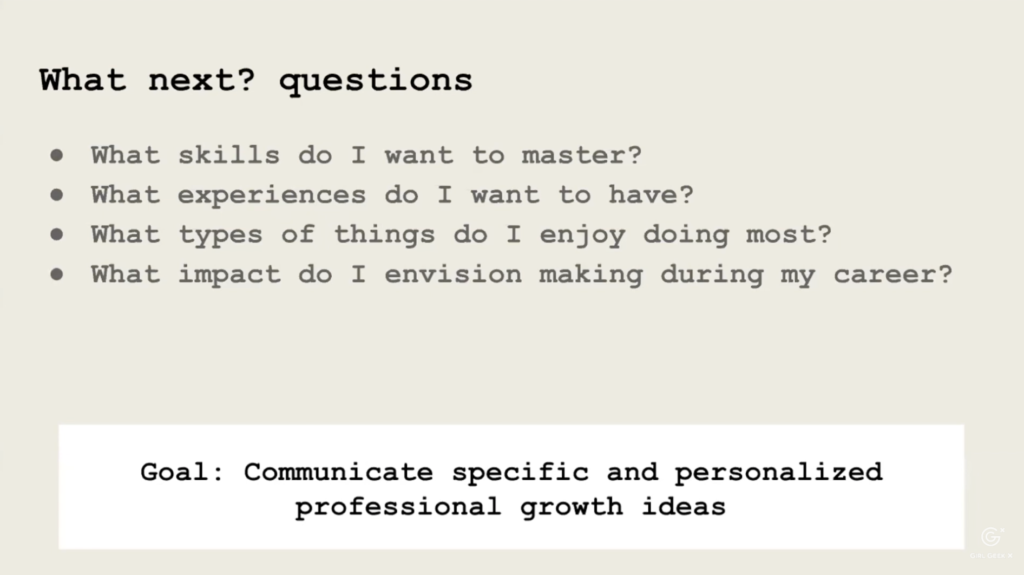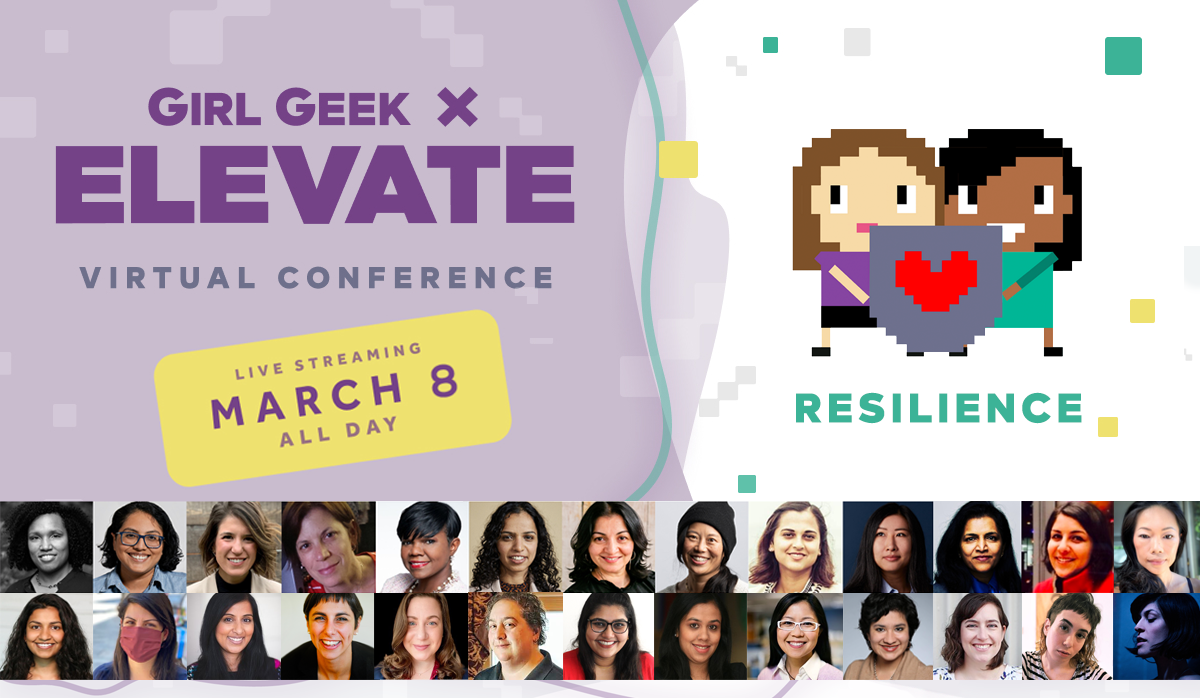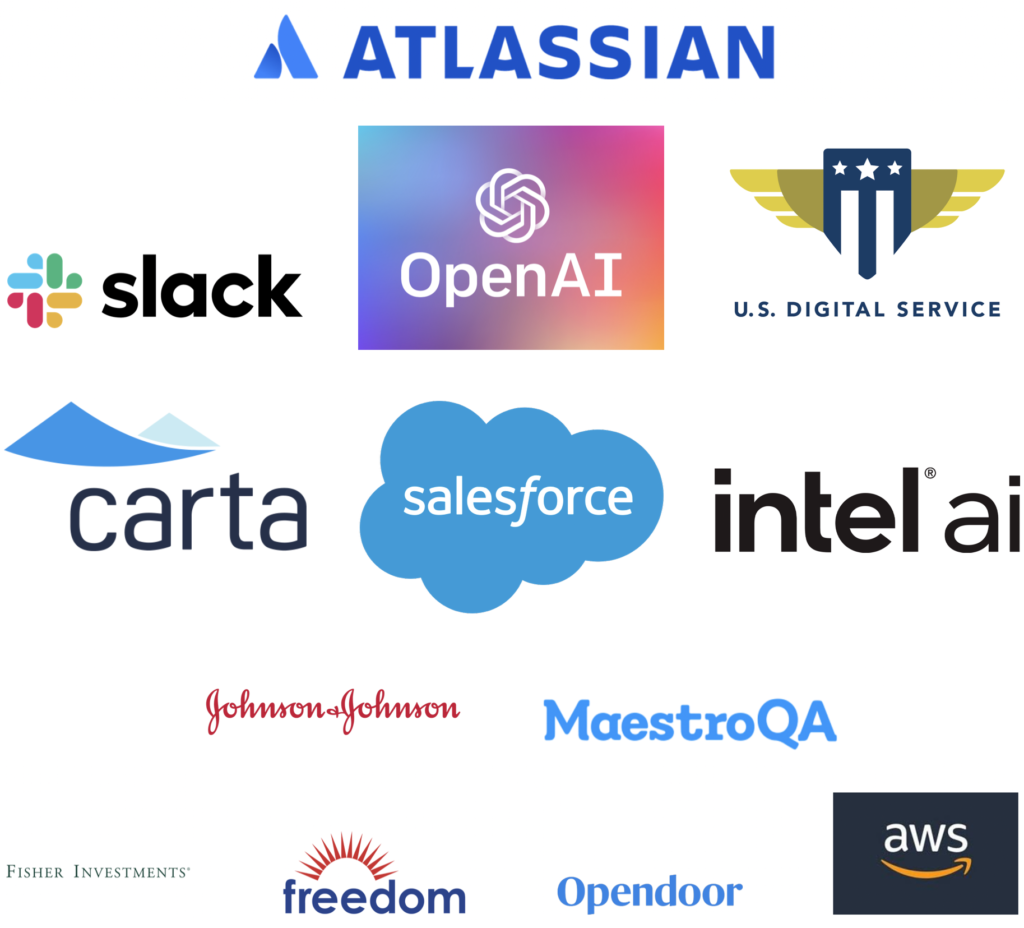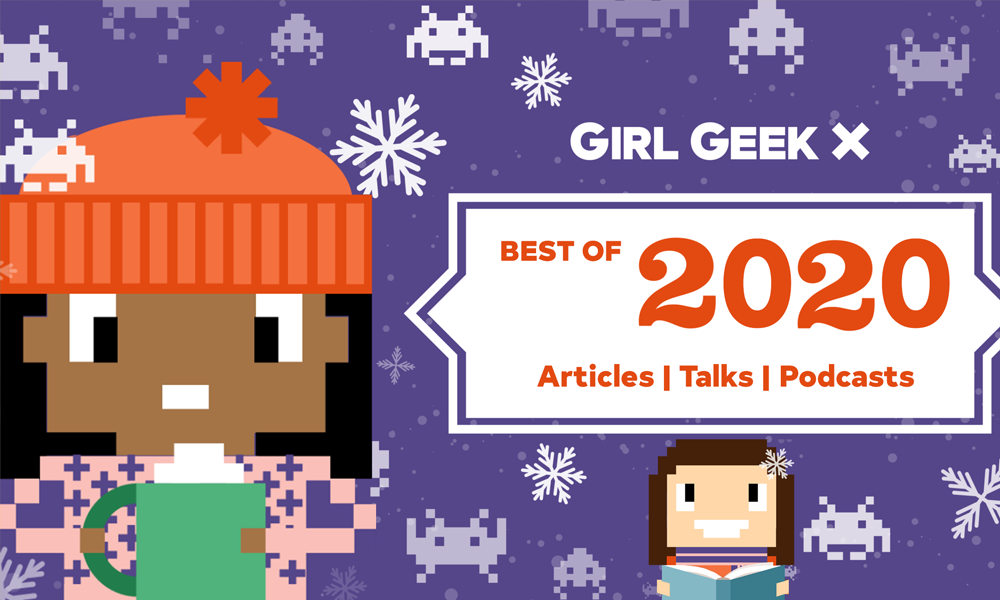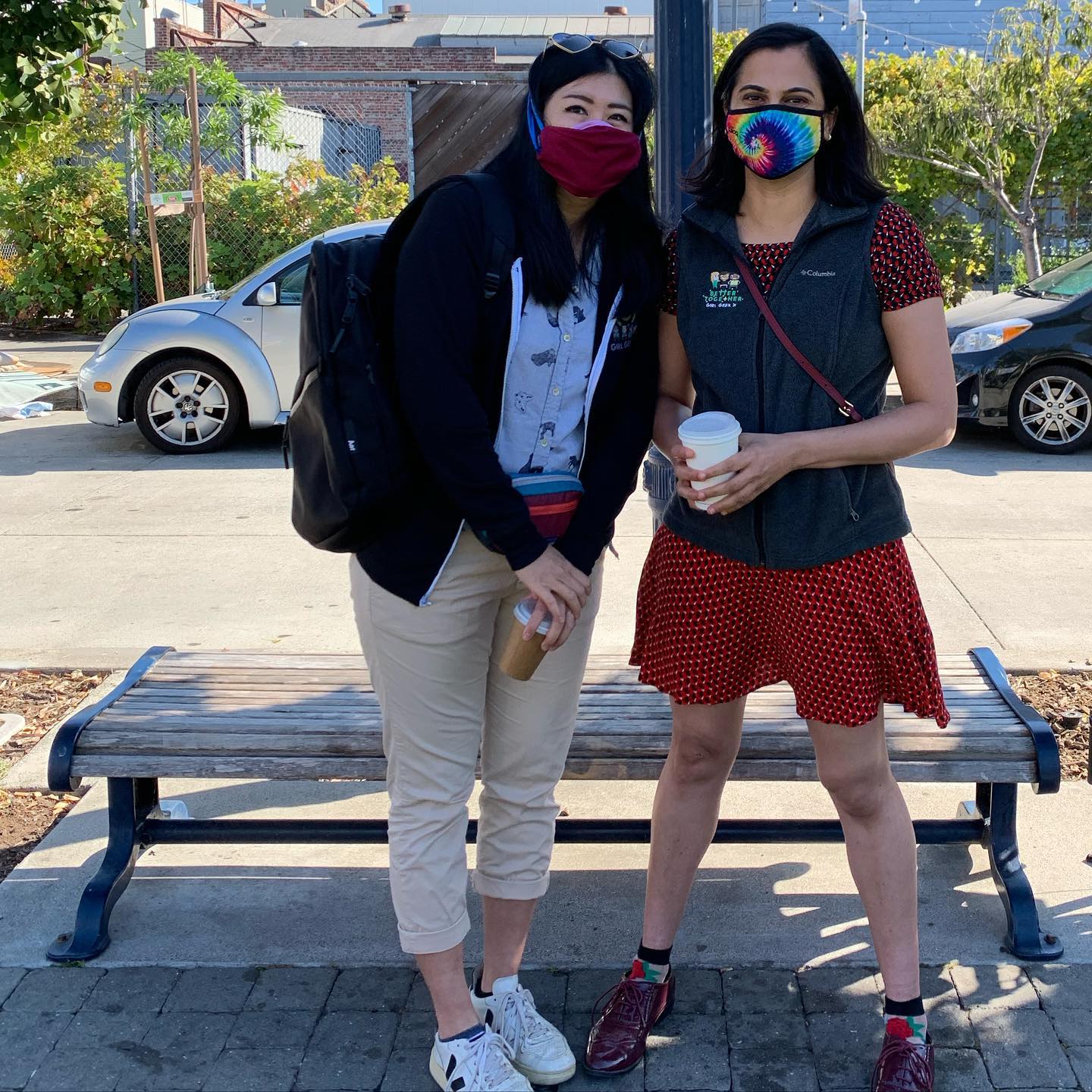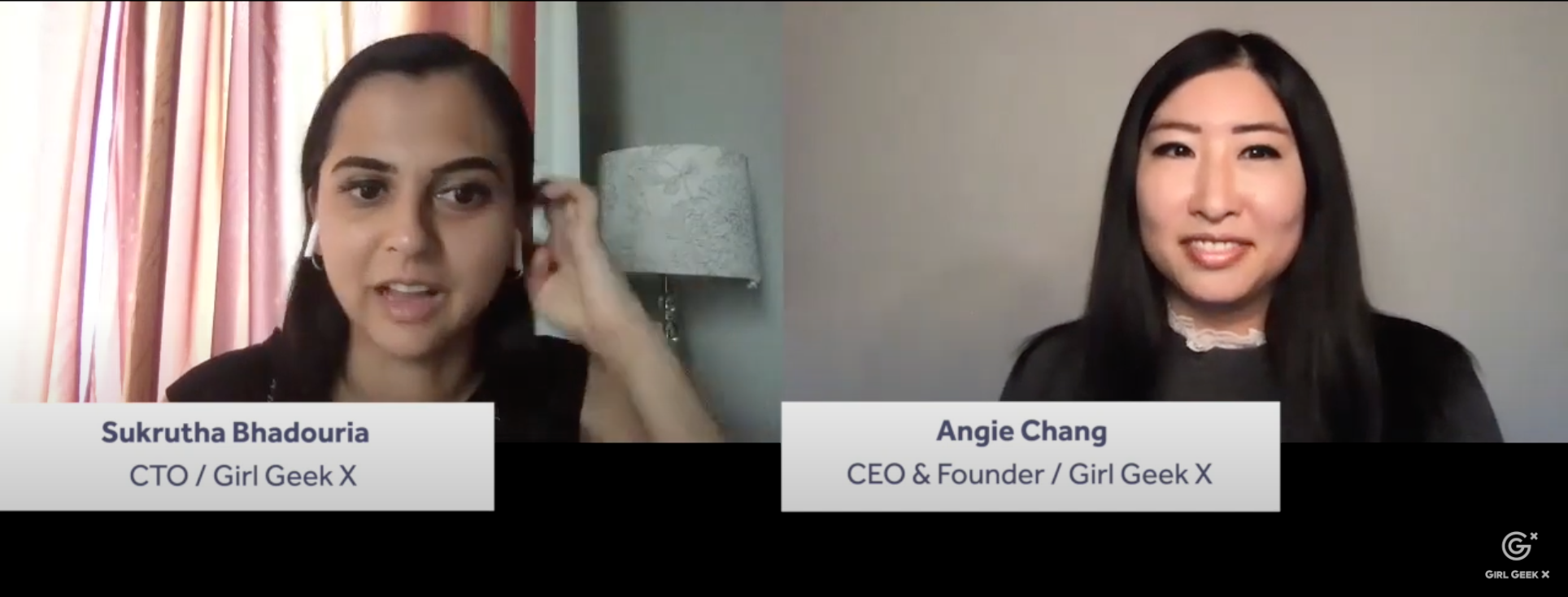Like what you see here? Our mission-aligned Girl Geek X partners are hiring!
- Check out open jobs at our trusted partner companies.
- Watch all Elevate 2021 conference video replays!
- Does your company want to sponsor a Girl Geek Dinner? Talk to us!
Transcript
Sukrutha Bhadouria: We’re going to now go into our next session. Like I said, it’s an amazing panel. The topic is “building high performance teams in a pandemic. I’m going to be joined by Rachana Kumar, who is the VP of Engineering [at Etsy], Elaine who’s the CTO at Change.org, Tina who is CTO and Founder at Transposit.
Sukrutha Bhadouria: Welcome ladies, I’m really excited to get us started. So first, because you’re such accomplished women, I don’t want to do you the injustice of trying to introduce you all. You will do a much better job yourselves. So please do go ahead and introduce yourselves and explain the different size of engineering teams that you’ll need. We’ll start with you, Elaine.
Elaine Zhao: Thank you. Thanks and happy International Women’s Day and I’m really glad that I have the chance to talk to you all and then share my ideas here. My name is Elaine Zhao and I am the CTO of Change.org, so my entire career is probably very similar to many of you, the start off as engineers and move up to the manager rank so I’m super excited to be here and share some of the ideas with you all, thanks.
Sukrutha Bhadouria: Tina?
Tina Huang: Hi. As Sukrutha mentioned, I am Tina Huang, I am the Founder and CTO of Transposit and we are a company that works on DevOps process orchestration so it’s great to hear a little bit of that last presentation on DevOps and this sort of up-and-coming nature. As a company, we were founded in 2016 and we are currently a Series B startup and around 50 or so employees total, about 20 something in engineering.
Sukrutha Bhadouria: Rachana?
Rachana Kumar: Hi all. First of all, happy International Women’s Day. I’m Rachana Kumar, I’m currently VP of Engineering and Managing Director for Etsy Mexico. So I have been at Etsy for about seven years so I’ve kind of seen now the whole growth from a smaller startup to a larger company now. Currently we have about 600 engineers and my org has about 150, 200 engineers and yeah, I also have a five-year-old son.
Sukrutha Bhadouria: That’s awesome. I mean, we should get right started. I kept getting questions like, “How does everyone define high performing teams?” Because that being the topic of this panel, let’s level set to begin with. How do each of you define high performing teams and how does this end up influencing the kind of engineers you hire for? Tina?
Tina Huang: Yeah, so Transposit has a few different core values but the one that is sort of nearest and dearest to my heart is we are a culture of pragmatism. And this really came about because at a number of different tech companies I worked for before, I worked at Apple, Google, Twitter, some of these kind of companies that really led the way for how we think about kind of engineering cultures, I found a lot of their tech ladders and the way they thought about what high performance meant is really like I could write a really, really strong and fast algorithm.
Tina Huang: That affected not only hiring and tech ladder and promotion but just the entire culture. I thought that was really interesting because what I saw was a lot of engineers who would hyper optimize a piece that was just not actually important to the holistic picture. So I wanted to build something different at Transposit and so we grounded this on this culture of pragmatism.
Tina Huang: What that means is that I really value everyone on my team to be able to really understand and empathize with the customer and the business value first and foremost, and then decide what is the appropriate amount of engineering to actually build for a particular piece of technology. Some people take that as when I say we are a culture of pragmatism, that you know we want hacky engineers.
Tina Huang: I think that there’s this perfect sweet spot with pragmatism and it’s really being able to understand is this piece of code something that is core to our system and is going to be run a hundred thousand times and we’re pretty certain it’s going to be part of our final product or is this piece of code for a prototype and it’ll be better to get something out to the customer sooner and get feedback and iterate more progressively.
Sukrutha Bhadouria: Yeah, and going from a startup like yours, I’d be interested to hear your point of view, Elaine. How do you define high performing teams and how do you do it at your company when you’re trying to build a high performing team? How does that influence your hiring process?
Elaine Zhao: I think probably no surprise that every engineering leader at all levels want to be a high performance team. That’s the ultimate goal. So I think the definition is really based on the why, why we’re doing that? And I think that have to take into account for the company strategy, the team strategy and goals and visions. At Change.org, the biggest social change platform in the world and under this umbrella, our goal and the vision is to become the undeniable leader in digital activism, right?
Elaine Zhao: We want people come, engineers come, to become the great engineers. And while they’re doing good for the world. So that really focused on couple areas and tied it up to our mission and vision then also tied up the two area that we want to bring and it’s one is higher experience engineers and continue to learn and improve the existing team that they both have to happen, right?
Elaine Zhao: We want to put a real emphasis on our user first because it doesn’t matter what we want to do, what we say we are good or not good, if our users not being served, then we cannot call ourselves a high performance team, so we really want to switch the emphasis to ours and focus on the user’s impact first, then come back and we drive the velocity, focus on learning and candor, that’s another thing that’s quite unique to Change or I would imagine many social mission focus engineering team as well that would tend to have a very strong culture already and how do we cultivate that we’re very caring.
Elaine Zhao: But when we so care about each other, then we sometimes forget about the best caring that we can have is actually make sure everyone continue to improve, right, we challenge each other to learn new skills and go up to the next level and that’s, whether or not you use the the words radical candor or be trusted, helping each other to succeed and that’s what we focus on and slightly different than many other companies in the world do, yeah.
Sukrutha Bhadouria: And then how’s your experience, Rachana, through seeing Etsy grow and then now expanding in Mexico?
Rachana Kumar: Yeah, I think both Tina and Elaine covered great points from customer focus to pragmatism to radical candor. So I’ll focus more on, as we’ve been scaling, how we are kind of thinking of scaling high performing teams. So in the past, we predominantly have had engineering teams in New York, San Francisco, and remote within the US. And over the last year or so, we have been expanding in Dublin and Mexico a lot.
Rachana Kumar: And for me, as we are ramping up hiring, they are starting to hire in these locations, one thing we are looking at is how do we take the aspects of starting from sourcing to hiring to onboarding to then forming your team, how do you then select projects in these new locations and countries for them to work independently? What kind of projects and what framework do we come up with?
Rachana Kumar: I’m looking with people at Etsy across the board. For me, we have not perfected it, we’re certainly just started figuring it out, how to scale. And there are a lot of other global teams that do that but I think Tina covered a little bit of this, right, what is our values that matters the most? Etsy is a pretty… other than specific skillsets like iOS and Android or DSML and things like that we are a pretty language agnostic company.
Rachana Kumar: We look at predominantly full stack and as long as you are interested and you’re a good engineer and the quality is great, other qualities like are you empathetic, are you kind of good at communicating when things don’t go well, all these basic things that are important for us here will be important irrespective of whatever the location is to build a high performing team, but also to bring all these people together.
Rachana Kumar:One thing I’m really trying to be mindful of is… because a culture has worked for us really well for over a decade, how do we be mindful of new cultures as we enter new countries and what is the best way to merge both of them and build teams together is what I’m trying to be more mindful about, talk more actively, yeah.
Sukrutha Bhadouria: Those are all great perspectives and it’s interesting how there is a lot of overlap no matter the size of the company and no matter where the company is expanding. But another aspect of building a high-performing team is getting the right leaders in place, whether it’s from a management standpoint or from IC leadership or technical leadership, right?
Sukrutha Bhadouria: There are times that you reach a crossroad where you’re like, “Should I invest in growing somebody to that leadership role, whether it’s a manager or a an IC, or should I be like hiring externally?” And different choices are made at different stages because building a team is literally like building a dynamic puzzle. You add something, it fits and then it changes the whole puzzle all over again, right?
Sukrutha Bhadouria: So, Elaine, what has been your experience in that whole aspect of choosing to hire versus grow when it comes to IC technical leadership roles? And when you when have you made the choice to do one versus another?
Elaine Zhao: All right, that’s always a a tough question to answer and leaders have to make that choice and decisions that are sometimes it’s external constraints. But what I also want to focus on, we have to look into, I like to focus on at that current stage of the my team and the company, what can we do and cannot do, right? At the current stage, I’m putting all the emphasis in hiring from outside. Part of that is when a huge growth phase, we need more people to the team and every time we need more people and it’s a perfect opportunity to bring in the right skill set into cultural add to the existing team.
Elaine Zhao: And also the other things that I want to highlight is a lot of time I participate a lot of conversations is about a building team and growing internally, we forget to think about whether or not the team itself, the company itself have the bandwidth, have the right mentorships and mentors in place to provide those mentorship to the ICs and all levels.
Elaine Zhao: I also want to focus on from hire outside there’s multiple things. However, of course, most the time we talk about hiring is hiring full time, but you can hire in fixed terms or short-term contractors, bringing the specific skill set to pair with your existing team to help them to fast-track the learning as well. You can also bring in specific skills in that way. Consultants is also a great way to do that.
Elaine Zhao: I cannot have emphasis enough about bringing in the external help to bring in those mentors only that is fair because a lot of time it’s not fair for the for the ICs and they want to learn but there’s no one for them to learn from. It becomes such a frustrating experience in my experience.
Sukrutha Bhadouria: Yeah and a parallel story is yours, Tina, where you were at the start of building your company, you have spoken about how you didn’t have management experience and then you had managers who didn’t necessarily have management experience as well. So how did you end up growing them in order to build the leaders that you needed?
Tina Huang: Yeah. I mean, I feel like Elaine is speaking exactly my language. I think that my experience is really for all of you who are out there building early stage startups, but I feel like one of the superpowers that women have is self-awareness and the willingness to kind of put your ego aside. So I was founder and CTO of the company but I knew very well that I had never been a manager, and as much as I’d like to think that I am an empathic person and I could learn that job, that’s very, very different than saying that I have had that experience and I place a high value on just domain experience that you can only really learn from doing that job.
Tina Huang: I saw early on, even though I really wanted the culture to sort of be grown internally and all that value from growing ICs into those leadership roles, well, I’ve seen just from observation a lot of my friends’ startups is they will grow their ICs internally, ignore the management problem, it’s always high risk to bring in your first VP of engineering, it could have a really, really catastrophic effect on your engineering culture, but the way they handle it is to just ignore that problem, right? So they are just growing their startup engineers into kind of quasi leadership, and then they hit a cliff, and all of a sudden there’s an emergency and a fire where you realize, we have a bunch of fairly… We just lacked that leadership experience, we needed it yesterday, and so then the company just gets external leadership and suddenly there’s this really, really strong culture shock to the startup culture.
Tina Huang: So we did exactly what Elaine’s talking about at a much larger org early, early on at Transposit. We hired an external contractor, this team, Bill and Amanda at this consultancy called Thrive Consultancy, and they worked with us and some of our ICs that were trying to grow into eng managers to sort of help understand our culture and build out that leadership internally.
Tina Huang: And I was very honest with the team, I said, “Look, if we grow at a fast enough rate, we will likely need to bring in outside leadership, but having consultants come in and help you all grow at least gives you all the opportunity. And that’s no guarantee that we won’t need that leadership, but at least you stand a chance. If we don’t bring in the consultants early on, we will inevitably have to bring in outside leadership and you will not have even had a chance to grow.”
Tina Huang: We were very fortunate that the internal eng managers, they had that hankering for mentorship, exactly what Elaine’s talking about. So they were really wanting that mentorship that I couldn’t provide for them, and at the same time, Bill over at Thrive that we’re consulting for, he likes to say, he got a little bit too close to the pond and just sort of slipped in. He fell so in love with our team and our culture that he agreed to come on as our VP of Engineering and really get deep into our team and our company.
Tina Huang: And that was really the best case scenario for us because we had the seniority of someone who honestly was too good for our company. He had previously been the VP of Engineering at Venmo and then was retired and we pulled him out of retirement to come work with us. So there was no culture shock there and we got a ton of great, great expertise added to our leadership team.
Sukrutha Bhadouria: That’s great. It’s always a win when you’re pulling someone out of retirement. Rachana, I’m curious to know your thoughts because IC leadership track versus the people manager track is something that people talk about in parallel but not enough of an emphasis on one versus another. So what are your thoughts on whether or not we should hire versus growth for leadership in general?
Rachana Kumar: Yeah I’ve not yet pulled anyone out of retirement so I don’t have Tina’s super powers, but yeah, I think it’s a balance, right? But to reach that balance, you need to reach a certain scale. After we reached a certain scale at Etsy, actually I can speak for my personal belief is if people want to get into management, that’s great, but that shouldn’t be the only way engineers can grow, right? And they’re very deliberate about having a very clear individual contributor growth track and a management growth track.
Rachana Kumar: And even within management, having said that, if someone is interested in becoming a manager, we have kind of process around that, they can try it for three months or they can interview for a role internally then it’s kind of like getting a new job within the company but there’s so much mentorship and support at this scale to make that happen for them.
Rachana Kumar: But also one way I kind of evaluate the question whether, let people grow internally or hire externally is… So at least with me and my directs or the whole manager… There are about 20 managers in my group, the cohort I think of as, say, between me and my directs what are the skill sets that we have significant gaps in right now, right?
Rachana Kumar: It might be technical. It might be industry experience. Or it might be just leadership experience. Like last year as a specific example, I hired a director of engineering for a initiative or a group within my larger group and there were already about four engineering managers and two of them were senior engineering managers and they both had absolute tremendous potential to grow into a director but between what my responsibility was and what they were doing, we could see there was a clear gap in terms of someone with significant management experience coming from the outside and being able to mentor both experienced managers and manage also more junior managers.
Rachana Kumar: And it was a hard conversation because the team had really talented managers within the group and so what was helpful was kind of laying out what are the gaps and can any of us fill that right now in talking about it actively.
Rachana Kumar: I feel like the conversation doesn’t happen enough similarly in the IC track until it’s very obvious that it’s a specialized skill set that we don’t have right now. And because our managers are also hiring managers in that sense, they understand when you sit down with them and I feel like because of that, at least most companies have seen, in the IC track, if they have a robust IC track, they end up promoting internally much more than hiring externally because we’re talking about technical skills here.
Rachana Kumar: In management, it’s easy to say someone at a director we need eight years for these reasons, so I feel like most companies, even if they have a clear IC track, end up promoting more internally.
Sukrutha Bhadouria: Yeah, that makes sense. And I mean all of your stories do resonate. I’ve worked in larger companies for most of my career. So now that we’ve talked about hiring and building, let’s talk about the dreaded f-word, firing. That is a really, really hard decision to make and it’s something everyone hates doing. It’s not enjoyable by any means, but it’s also not something to be afraid of. So, Tina, I’d love your perspective, let’s start with you on why it is an important skill for managers to learn?
Tina Huang: Yeah, this is something that came up recently, I think actually, as we were meeting up to talk about this panel here where, especially during the pandemic when we know that everyone’s struggling, it’s like how do you have hard conversations and then the most extreme of those is the conversation to terminate employment. And I was thinking about having to have those conversations as well as the follow-on, which is explaining to your team the necessity for these.
Tina Huang: I had previously always thought of the need for firing as part of–I think if you all have read the book, Netflix: No Rules Rules, the need to preserve talent density. And that always had a lot of resonance to me because, as an engineer, I really appreciated working on teams with very, very high talent density.
Tina Huang: But from the leadership perspective, it always struck me as almost a bit of arrogance, and so I sort of went on to a little bit of a philosophical journey to sort of reflect and think, why do I think that it’s so important or what’s another way of thinking about why it’s important to fire?
Tina Huang: One of the things that I realized is, for a lot of companies out there that I’ve seen, there’s a huge difficulty in firing and a huge sort of aversion to doing so. And so you put people on performance plans, you go through a whole rigamarole, oftentimes just transition them to another team. But what this actually ends up happening is this corollary on the hiring side.
Tina Huang: Because we’re so afraid of letting people go and oftentimes just because they aren’t a good fit for the role, not because they aren’t a smart, talented, wonderful person, that leads us to set these ideas on the hiring side which is, when in doubt, don’t hire. And this is something that was very, very common when I was working at Google, which at any hiring panel, if you weren’t 100% sure, you were told vote no on the hire. And so what does that mean?
Tina Huang: Well, if you have this notion that says when there’s any sort of doubt don’t hire, you’re going to look for high pedigree, people who are from known goods, go with your previous pattern matching, go for elite universities, for brand name tech companies, because it reduces doubt. And this is a way that you actually end up with a lot more bias in your hiring process because you’re unwilling to take a risk on anyone who adds a diversity to your company.
Tina Huang: So I started having this framework of thinking about what I told my engineers for how to think about hiring, which is this risk versus reward framework. Rather than thinking of just purely doubt, it’s like, we try to think about what is the risk of this hire but what is the upside that you can have by doing this hire and diversity of experience, diversity of thought, is a huge upside, in our perspective and so we’re willing to take risks if we see a potential hire has high upside but sometimes that risk comes at a cost.
Tina Huang: And so as an organization, I’ve been trying to coach my engineers to feel more okay about giving negative performance reviews when necessary because that’s the only way that we can continue a culture that allows us to take high risks and have a very, very diverse team.
Sukrutha Bhadouria: Yeah, these are really important thoughts and you see, when you get the chance, that people are resonating with what you’re saying and they’re adding their thoughts as well in the chat. I do want to take a little bit of a tangent because, Elaine, your stories are not so much about firing but when you have this mutual agreement that the path or the partnership that you had with somebody may not be the right one anymore, so not so much a firing but a polite handshake, let’s meet again, maybe.
Elaine Zhao: Yeah. No, absolutely right. Instead of just talking about firing and I prefer to use the word “part ways” with the staff that the core of the any of these issues is that working relationship no longer works, no longer right, but whether or not it’s performance related, it is skill set related, it’s the drive, the desire, the company wants to go to one direction, the employees career path go a different direction, whatever it is, we need to face that both sides need to face it and then treat it as fully grown adults.
Elaine Zhao: You don’t force a relationship nowadays if we all know it doesn’t work, right? People know and employees know it too. For us to so afraid to talk about performance-related firing or whatever reason that are no longer the right fit and just work around it, we don’t treat each other with the respect in a basic, we don’t believe that employees can understand that we try to treat them as a kids. And that is something that I fundamentally disagree with, we need to treat each other with respect that we’re fully grown adults. Let’s talk about it, right?
Elaine Zhao: What is the best way out? I have heard stories these days and the pandemic people challenge question about we shouldn’t fire people because due to performance because it’s pandemic or shouldn’t be a performance plans, whatever it is. And I think that is really not doing those employees the justice. Instead, we need to open the conversation. If the concerns about because the pandemic, financial related issues, there’s so many way that we can do it right with empathy see and I will take care of that.
Elaine Zhao: Let’s face, it what is the best way to help forward or not that’s a layoff situation, firing situation, a transition. And one last thing sort of talk about not talking about these topics objectively is when we’re avoid doing, make the tough decisions, we actually treated the best performers, our high performance, the worst. Those who deserve the most from the leaders, they end up received at least, right?
Elaine Zhao: When we’re kind of letting the low performance hanging around when there’s no longer the right relationship, right fit there, we actually treat our best performance worse. And guess what, we’re going to lose those top performers or we turn the top performance to mediocre performance, and I think that’s exactly the opposite that we wanted to see, right?
Sukrutha Bhadouria: Yeah, and I mean oftentimes letting go of someone feels like a difficult decision not just because of how they’re doing but because of how that can cause an impact on the project deliverable. And, Tina, you spoke about encouraging your employees to not be afraid to give negative feedback so I want to go to you now, Rachana, because you were that person who wasn’t afraid to give that feedback and then you saw a difficult decision being made based on that. So do you want to go into that?
Rachana Kumar: Yeah sure. I think both Elaine and Tina made great points. At any given point in time, letting go of anyone is a hard decision. But for me, this was very early on in my career, I was a tech lead and we were working on a project that had like crazy tight deadlines and my manager said, “Can you peer program with another engineer and what if you try to finish something we were struggling with as soon as possible?”
Rachana Kumar: And I went and sat next to him and we were peer programming and I made a suggestion on how we both can best… A technical suggestion for whatever we were working on and he turned towards me and he basically said, “I don’t want a woman telling me how to code. I know how to do my job well.”
Rachana Kumar: And it of course it made it very challenging for me to continue peer programming at this given point in time. I just got up and I realized I had to tell this to my manager because this expectation was we are peer programming and we are going to finish it and after a comment like that, continuing peer programming and I was also new to the US and I said person new to a country and understand still understanding the culture and all those things I was very afraid to say anything. But I felt like I had to tell my manager what he said even because I had no idea what the outcomes were and I was certainly very nervous. I just went and told my manager. “I don’t think we can continue to peer program because this is what he told me.” And my manager actually let him go immediately.
Rachana Kumar: And for me, I have been manager for over a decade but the learning from that incident was… That put the project at risk and the team’s execution at risk but he chose not creating a toxic work environment, especially for minorities, over the project outcomes, which for me was a really good learning experience as a leader and that’s something I always keep in mind because it’s not just about what business and customer outcomes you’re driving, it’s about the culture you’re driving, and it’s like, even if someone sometimes a high performer, if they’re toxic to the culture, it’s a really hard decision to make but it’s an important one.
Sukrutha Bhadouria: Yeah, that’s a very brave story and I’m glad it ended up in a positive outcome and not just for you but the lesson and the message that was being sent that a toxic environment is absolutely not okay by any means. So now we’ve talked about hiring externally versus growing people versus identifying when it’s time to part ways. We all are very aware that the traditional tech promotion systems, we haven’t figured it out. So let’s talk about the problems with it, right? So what are some of the challenges we see with how it is today? Elaine, let’s start with you.
Elaine Zhao: Talking about getting the opportunity for us, I think couple of things here is, first thing first, you have to, my experience, that have to focus on the opportunity in front of me, which is my current job, right, and actually do a good job in it and I know there’s a lot to talk these days about people not getting noticed but I can tell you if you’re not doing a good job you absolutely would not get noticed. All right. So focus on that one first.
Elaine Zhao: And the other area is really I learned my lesson that I really set the expectations with my manager, I also recognized a very fortunate that I have earlier my career I have one leader, manager hired me four times at four different companies so he become my mentor. The key thing is to really understand the manager’s perspective, and in my case, what he sees I should focus on and go from there. Now there are situations which I also experience my career, especially later in my career, when I get in the more upper management level. It’s just a misalignment.
Elaine Zhao: At that time though, I got bigger responsibility that my focus is actually to talk to peers and talk to different folks within the company to understand a higher level, not just engineering, not just my team, but the overall challenges are other leaders facing and then see what I can help whether or not a [inaudible] standpoint or just technology strategy standpoint that I can meet my team and collaborate with them and that is actually really for me have been served me really well, because the ultimate goal is not just whether or not me getting noticed or do a good job is whether or not we solve a problem, solve our customer’s problem, and I think that’s the most important thing that we need to focus on, yeah.
Sukrutha Bhadouria: Yeah. And for you, Tina, what do you think are the challenges with the current situation, in terms of how we have the traditional promotion expectations that we have in the tech industry?
Tina Huang: Yeah, so one of the things I noticed from my experience, primarily at Twitter, was I realized that a lot of times one of the challenges is we think a lot of aspects of technical, what was on the tech ladder, is highly quantitative when it really is fairly subjective. And the example that I often give is around code quality.
Tina Huang: Code quality and even the fact that we use it as a metric makes it sound like it is a quantifiably measurable thing that you can look at someone’s code. When in practice, if you think about it, code quality is highly subjective depending on what was that purpose for the code. If the code was to try to get a prototype out or meet a very, very aggressive customer deadline, the best quality code is the code that will actually ship on time. Whereas, if it’s part of a long-term project, the right quality of code might be higher performance or higher reliability, if those are aspects of the system that you really care about. Similarly, when you talk about something like code quality, there’s also, I almost say a historical lens that people try to put towards it, where they evaluate the code without any sort of thinking around what was the context that the code was written in?
Tina Huang: So I was at Twitter in the very, very early days and so there would be questions around, “Why was this code not written on top of this other library?” And no one bothered to look at it and say, “Oh, that library didn’t even exist when we actually wrote that code.” And so one of the things that I try to do very differently at Transposit is I try to think about, set very good high level value metrics that the company should be driving for, especially on the customer and product side and rooted in that aspect of pragmatism that I talked about earlier, and then use that to sort of drive the metrics. What are the product deliverables, the guidelines, et cetera, and then have that sort of cascade into what is the appropriate quality of code to evaluate on?
Sukrutha Bhadouria: That’s awesome. Yeah. I mean, I don’t think people are really realizing how difficult it is when it’s subjective or not, right, in terms of evaluation. So I’m curious now next, I mean, Tina, you’ve had an amazing career, all of you have, and not everybody has had opportunities handed to them. Sometimes we’ve had to make it for that for ourselves. So how have you done that for yourself, Tina?
Tina Huang: Yeah, one of the things that I hear a lot from various engineers is they come to me and they say, “Hey, it’s not my fault, I’m not given the right projects in order to hit that next technical milestone, to get the leadership or the technical kind of benchmarks necessary for that promotion.” I often talk about how when given a project, you can take it very, very literally and just execute on that project or you can try to think bigger picture around what are the actual goals and the necessities there?
Tina Huang: I think people often look at my experience and they could say, “Hey, Tina, you became a CTO by creating your own company that feels highly, highly unapproachable to me.” I often like to talk about some of my experiences navigating larger companies at Google or Twitter to sort of better ground that into real world examples or examples that feel a little bit more approachable.
Tina Huang: One example was at Google, we were asked to do a front-end redesign. And so we were given some mocks and the obvious solution would be, let me just write a new front-end for Google News that executes against these mocks. Instead, I looked at the actual architecture and what it would take to build that. And at Google, believe it or not, back in the day, for all of their search infrastructure, including Google News, the front-ends were written in C++.
Tina Huang: And I said, “Hey, this is highly unscalable to have and even hire for engineers that both know C++ and also know Javascript and to be able to build a modern web front end with all of these bells and whistles there. So why don’t we take an approach that actually shards that old C++ front-end and make it into an API server and build a Java front-end on top of it?” Because we had a lot of Java expertise at the company, because all of the Google Apps were built on top of Java.
Tina Huang: And so I was a fairly junior to mid-level engineer at the time but I championed this to a bunch of the senior technical team members and pushed forward to actually re-architect the system. And that’s how you take a project that is, on face value, not technically sophisticated and actually turn it into something that is worthy of a promotion.
Sukrutha Bhadouria: Yeah, it’s really inspiring to hear how one shouldn’t just stop at what’s not in front of them. All right, so on that note, do you, any of you have any closing thoughts you’d like to share, Rachana, let’s start with you. What are your thoughts you’d like to close with in a pandemic situation for everyone?
Rachana Kumar: Yeah, I would just add to what Tina said because I think that’s so interesting about making opportunities for yourself and even for me, throughout my career, it’s been like kind of looking for things that no one is in my peer group, there are obvious problems, but either it’s not glamorous or it’s too risky and no one wants to own and kind of seeing…
Rachana Kumar: Because I know it’s an important problem but no one thinks it’s glamorous enough or exciting enough, owning those and working on them it’s been how I’ve created opportunity and that ties to also the promotion conversation. A lot of my promotions have come because I found a pattern and a problem, either small or big, depending on the stage of my career, and kind of paid attention to it.
Rachana Kumar: During the pandemic, with everything from child care to everyone going remote suddenly, how do you make mind space for that has been really challenging for me and the Mexico job was an interesting one. When they offered me that, it’s again a risky one, we had to move there so in the next few months and things like that. But I’m trying to still keep an open mind to what has made my career successful even during the pandemic, even though it’s hard.
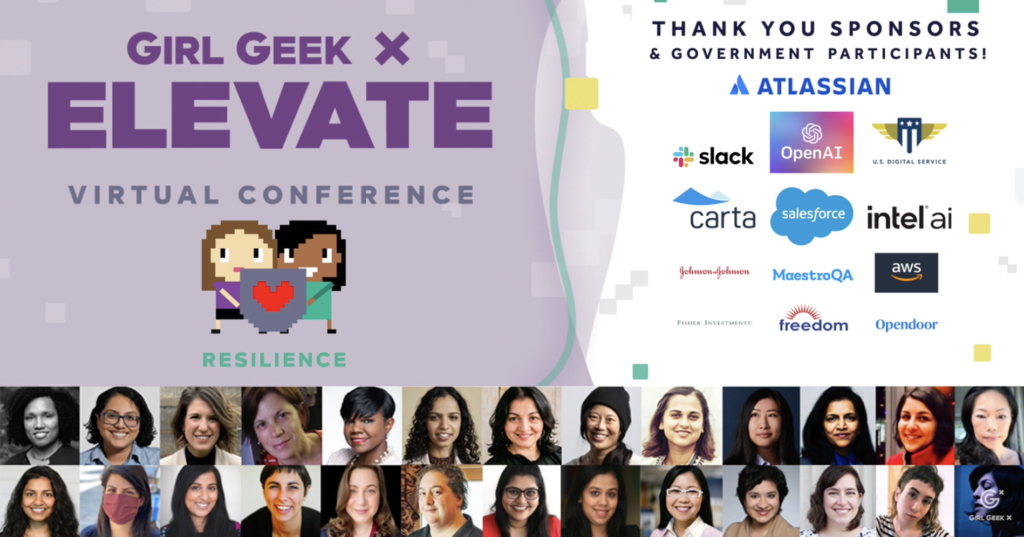
Like what you see here? Our mission-aligned Girl Geek X partners are hiring!
- Check out open jobs at our trusted partner companies.
- Watch all Elevate 2021 conference video replays!
- Does your company want to sponsor a Girl Geek Dinner? Talk to us!


